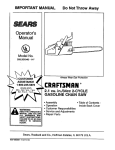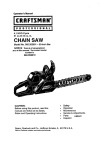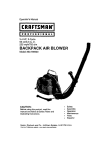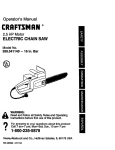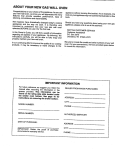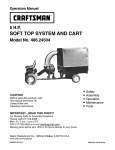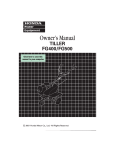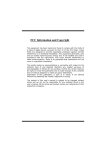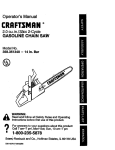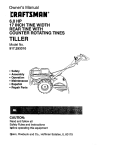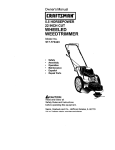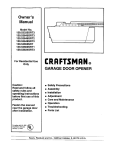Download Craftsman 360.352001 Operator`s manual
Transcript
Operator's Manual iPROFESSIONAL i 4.1 HP/2-Cycle 51 ccJ3.15 cu. in. CHAIN SAW Model No. 360.352001 - 20-inch Bar CAUTION: Before using this product, read this manual and follow all its Safety Rules and Operating Instructions. • • • • • • Safety Operation Maintenance Service & Adjustments Parts Espa_ol Sears, Roebuck and Co., Hoffman Estates, IL 60179 U.S.A. Visit our Craftsman website: www.sears,com/craftsman CAUTION: Always disconnect spark plug wire and place where it cannot contact spark piug to prevent accidental starting when setting up, transporting, adjusting or making repairs. TRAINING Read the operator'smanual carefullypriorto operation.Become familiar with the conll_._a_d I_now how to operate yourchain sew pmpe_ i"-- , OPERATION • ,rt tVi . • i Keep the area of operationclear of_!_ons • • manual. DOnot atlowcTran • • proper ins_ns, k,,,.__,,,,O_3Mnt:.._ Do not operate the chain saw ifit hlF._p_ ,; _R .,,.--..-to operate )_bl_ Z!] _saw. • u,_v_=J.. J=.,.=_o-..,=..y,,.=,n_.'J_v_shave damage repairedbefore using your chainsaw. Use only recommendedCraftsman accessories and replacementparts. Use of non-Craftsman parts and accessoriesmay be hazardous. • • PREPARATION ,j • Always wear safety glasses or eye shieldswhen starting and while using your chainsaw. • Dress properly.Do not operate chain saw when barefoot or wearing open sandals. Wear onlysolid shoes with good traction. • Wear long-sleevedclothesthat are snugfitUng. ' Avoid weadng loose clothing. • Wear either tightlycuffed or cufflesspants. • Wear headng protectioneven when workingfor a short pedod of time. Remember - haadng damage is cumulative. • Wear protective,non-slipglovesfor safer operation. • Always wear a =hardhat" in the workingarea. Overhead hazards such as falling limbspresent danger of injury. • Alwayswear safety bootswith steel toes. • Check fuel tank before starting engine. Do not fill fuel tank indoors,when the engine is runningor when the engine is hot. Allow the engine to cool for several minutesbefore filling the fuel tank. Clean offany spilledgasoline beforestartingthe engine. • Always make adjustmentsbefore startingyour chain saw. Never attemptto make adjustments while the engine is running. • Use only in daylightor good artificiallight. • • Keep your eyes and mind on your chain saw. Do not let yourself be distracted. Always be sure of your footing. Use extra caution in wet or slipperygrass. WALK - DON'T RUN. Do not put handsor feet near rotatingparts.Keep clear of chain at ell times. Always stop the engine whenever you leave or are not usingyour chain saw. Before cleaning, inspecting,or repairingyour chain saw, stop the engine and make absolutely sure ell movingparts have stopped. Then disconnectspark plug wire and keep it away from the spark plug to prevent accidental starting. Do not adjustcarburetor. Ovarspeeding engine may result in engine damage or personal injury. Do not run the engine indoors.Exhaust fumes are dangerous. Never operate your chain sew without proper guards or other safety devices in place. Never remove hands from chain saw handles when activelycutting with the saw. WARNING: CaliforniaProposition65 The engine exhaust from this productcontains chemicalsknown to the State of Californiato cause cancer, birthdefects, or other |:eproductive harm. KICKBACK CONDITIONS AND PREVENTION Kickbackoccurswhen the upper quadrant of the bar nose contacts a solid object in the wood or is pinched, This type of contact stops the chain for an instant.The resultis a lightningfast reverse reaction of the chain; causing the bar to "kick"up end back toward the operator. Under some circumstancesthe operator (Fig. I) may suffer severe or fatal injury.Kickbackmay also occurdudng limbing (See LIMBING). RGURE 1 Kickback path 3 second. The chain brake can also be engaged manually by pushingthe lever-handguardtowards the frontof the saw untila loud click is heard. The saw shouldnot be run above idle for more than a few secondswith the brake engaged; otherwise damage to the saw will occur. TO AVOID KICKBACK The best protectionfrom personal injurythat may resultfrom Kickback is to avoid Kickbacksituations. • Hold the chain saw firmlywith beth handsand maintain a secure grip, • Be aware of the location of the guide bar nose at all times (Fig, 2). RGURE 2 To properlydisengage the chain brake; firmly pull the [ever-handguard back towardsthe hand[e (Fig. 3) until a loud click is heard. Failure to completely disengage the brake properlywill cause excessive heat build-up on the brake band which, in turn, can cause severe damage to the saw body. Oor_ lettheI_r ¢o_=t _ gmurtd • • • • • • • • • • • Never bdng the nose of the guide bar in contact with any ob|ect. Do not cut timbswith the nose of the guide bar. Be especiaUycarefulwith small, tough limbs, small-size brush, and saplingswhich may easily catch the chain. Don't overreach. Don't cut above shoulder height. Do not use a chain saw while standingon a tree or [edded Begin and continuecutting at full throttle. Cut only one lot at a time. Use extreme caution when re-entering a previous ,cut. Do not attempt plunge cuts if you are not familiar with these_utting techniques. Be alert of shiftinglog or other forces that may cause the cut to dose end pinch the chain. Maintain saw chain properly°Cut with a correctly sharpened, properly tensioned chain at all times (Use a 4.5-ram file). Stand to the side of cuttingpath of the chain saw. tf the cut ctoses on the bar, STOP the saw. Use a wedge to free the saw. Do not try to free it by pullingthe handle. CUSTOMER • • RESPONSIBILITIES Read and observethe safety rules. Followa regular schedule in maintaining, cadng and using your chain saw. Followthe instructionsunder the Maintenance and Storage sectionsof this manual. • SPECIAL NOTICE: For users on U.S. Forest Land end in some states, including California (Public Resources Code 4442 end 4443), Idaho, Maine, Minnesota, New Jersey, Oregon and Washington: Certain intern!!(combustionengines opere.tedon forest, brush,and/or gress-covered lend in the above areas are required to be equipped with a spark arrestor, m_dnt_nedfor the prevention of fire. Check with your state or localauthoritiesfor regulations pertaining to these requirements.Failure to follow these requirementsis a rio|orion of the taw.Thi s unit Is not faotory-equipped with a spark arrestor;, however, • spark arrestor is available as an optional part. If a spark arrestor is required in your area, contactyour Authorized Service Center for the correct kit. WARNING: A dull or improperlysharpened chain may increase the risk of Kickback.Always cut with a properly Sharpened saw. improper loweringof the depth gauges also increases the chance of kickback. :_.$"1=l_rJl:!ll" Your new chain saw has been assamb',edat the factory.No further assembly is necessary. ABOUT THE CHAIN BRAKE The main components of the chain brake assembly are the [ever-handguard and a brake band aroundthe clutchdrum. The brake is automaticallyengaged when kickback occurs. When engaged, the brake band clamps down around the clutch drum, stoppingboth the drum and the chain in less than 1/10 of one • • o(o]_1 / :1_I I-lo] :uof:1-1 I[O]_ Chain Saw Combi-Wrench Read these instructionsand the operating manual in its entiretybeforeyou attempt to operate your new chain saw. 4 The followingitems for the operation of your chain saw are available at your nearest Sears store.. • Safety goggles • Airfilter • Hearing protection , Fuel Stabilizer • Gloves • Spark plug • 2-Cycle air cooled engine oil • Gas can KNOW YOUR CHAIN SAW Read this Operator's Manual and Safety Instructionsbefore operating yourchain saw. Compare the illustrationbelow (Figure4) with your chain saw to familiarize yourself with the locationof various controlsand adjustments.Save this manualfor future reference. 14. Half Throttle Pin (Pg. 6) 15. Side Cover 16. Top Cover 17. Lever- Handguard (Pg. 4) 18. BuckingSpike 19. Chain Tensioning Screw 20. Chain Tensioning Lug 21. Clutch Drum 22. Chain Brake Sand 23. Oil AdjustmentScrew 24. Sprocket 25. Serial Number 1. Spark Plug 2. Air Filter 3. Primer 4. Choke Lever 5. On-Off Switch .6. Safety Lever 7. ThrottleLever 8. Fuel-OilMix Cap g. Cover Over Pra-FUter 10. Bar-Chain Oil Cal) 11. Bar 12. Chain 13. Bar Nuts FIGURE 4 GASOUNE bearingsand other moving parts. The correct fuel- oil mixtureis 40:1 (see Fuel Mixture Chart). Too littleoil or the incorrectoil type will cause poor performance and may cause the engine to overheat and seize. AND OIL MIXTURE Important! Do not use automotive or boat oils in your chain saw. These oils do not have proper additives for 2-cycle, air-cooled engines and can cause engine damage. Gasoline and oil mustbe pramixed in a clean approvedfuel container.Always use fresh regular unleadedgasoline.This engine is certifiedto operate on unleaded gasoline. The 2-cycle engine on this productrequiresa fuel mixture of regular unleaded gasolineand a high quality 2-cycle air-cooled engine oil for lubricationof the 5 FUEL MIXTURECHART GASOUNE OIL 1 Gallon 3.2 Ounces 2.5 Gallons counterclockwise(+) increases the amount of oil, clockwise(-) decreases the flow. Never cut without chain lubrication.Check proper level before each cutting. I I FIGURE 5 8.0 Ounces IMPORTANTI Alcohol blendedfuels called gasohol (using ethanol or methanol) can attract moisture, which leads to fuel - oil separation'andformationof acids dudng storage. Acidic gas can damage the fuel system of an engine while in storage. To avoid engine problems, the fuel system shouldbe emptiedbefore storage of 30 days or longer. Drain the gas tank, then run the fuel out of the carburetorand fuel linesby startingthe engine and letting it run untilit stops. Use fresh fuel next season. See storage instructions for additional information.Never use engine or carburetor cleaner products in the fuel tank or permanentdamage may occur. STOPPING ENGINE •To stop engine, release the throttle lever. Move the On-Off switch to the off (STOP) position. STARTING COLD NOTE: Check ©haln tension before starting! 1. Tum the on-off switch to the on "1"position. 2. Pull out the choke knob. The fast idle stays set until the throttle is depressed, at which time the red pin inside the choke lever retracts (idle position). CAUTION: Retain a secure gdp on the saw using the foot and hand positionfor startingthe chain saw in a safe manner. 3. Pump fuel pdmer until it is approximately ½ full with fuel and increased resistance is felt. Proceed with coldstarting instructions. 4. Slowly pull on starter gdp until rope encounters some resistancefrom starter pulley. Next, pull ropefirmly and rapidly in an upward motion. Guide rope back into starter rather than lettingit snap back. 5. Repeat rope pulls until engine attemptsto start, usually2-3 pulls, no more than 5; then immediatelypush in choke knob. 6. Once the engine is steadily running depress and release the throttle lever to allow engine to operate , at idle speed. NOTE: Depressing (and then releasing)the throttle lever releases the halfthrottleautomatic lock and the red indicatorpin on the choke knob retracts.The engine continuesto runat idle speed. 7. Shouldthe engine fail to start after several repeated starting attempts, the engine has already been "flooded"(too much fuel mixture in cylinder). in this case, remove the spark plug and dry it. Set the ignitionswitch to "stop"and the throttlelever to fullthrottle.Crank engine by pullingthe starter ropeseveral times to vent fuel mix and vapors from cylinderand crankcase. Check spark plug gap (.015-.020"); correct if necessary. Reinstall spark plug;connect spark plug cap. Set ignition 2-CYCLE O|L Craftsman 2-cycle, air-cooled engine oil is specially blended with fuel stabilizers.If you do not use this Sears oil, you can add a fuel stabilizer,such as Craftsman No. 33500, to yourfuel mix. FUEL STABILIZER A fuel stabilizer is an acceptable a_f'emativein minimizing the formation of fuel gum depositsdudng storage. Add stabilizer to gasoline mixture in fuel storagecontainer and mix well. Always followthe fuel mix ratio found on the stabilizer container.Run engine at least 5 minutes after adding stabilizerto allowthe stabilizerto reach the carburetor. You do not have to drain the fuel tank for storage if you are usingfuel stabilizer. _ BAR AND CI_IAIN OIL We recommend e special chain oil (low sling, high tack) to lubricateyour bar and chain; consult your local Sears retailer. Dudng chain saw operationsat temperatures below freezing (00C/32*F), the chain oil viscosityincreases creating an ovedcad to the automatic oil pump. Overloadingresultsin damage to the driver gear, pump mechanism, and bar and chain. A specialcold-climate chain oil shouldbe used. Refill chain oil each time you refuel. CAUTION: Never use waste engine oil; it will damage the pump. OIL PUMP Your chain saw is equipped with an automaticoil pump that pumps oil to the chain when the chain is rotating. You may adjust the amountof oil pumped to compensate for long bars and chainsor for extremely hard or frozen wood. Adjust the flow rate by turningthe adjustmentscrew. The adjustmentscrewis locatedon the bottomof the saw below the markings+ - on the same side as the bar and chain (Fig. 5). Turning 6 STARTING WARM 1. Pullchoke knob out. 2. Pushchoke knobback into open position,red indicator pin on choke button remains visible. 3. Crank engine and allow to run briefly. 4. Depress throttle lever to allow engine to run at idle speed (indicatorpin disappears). RGURE 6 If you are unsuccessful[in starting the engine, consult the Troubleshootingguide in your Craftsman chain saw handbookor contact a Bears Service Center. Beforefelling a tree, survey it carefully and answer these questions: 1. In which directiondoes the tree lean? 2. Is the condition of the trunk sound, hollowor partiallyrotten? 3. From which directionis the wind blowing? 4: What is the wind velocity? CAUTION: Wind directionand velocitymay change. Be alert! Fellingshould not be attempted in high winds. 5. Isthe crown (top) of the tree more dense and heavieron one side? These are factors and forces which will influencethe line of fall and escape routes. Survey the area; make sure that felled trees cannot strikeany objectssuch as power lines, buildings,cars and blockroadways or railroad tracks. Insure that neither persons nor animals are within the danger zone (measured distance away from tree that is 21,_ timesthe tree height). Clear escape route by removingundergrowthlikelyto intedere with es_c_....Be sure to warn othersby shouting"TIMBER when e tree is about to fall. Bdef each team member on properescape proceduresand signals. Have visualcontactwith team members prior to and during fellingoperation.Practice a "dryrun" escape! Prior to fellingprepare the immediatesite and the base of the tree by clearingaway undergrowthwith an axe, not the saw. Undergrowthcan tangle up or snag the saw chainresultingin serious injuryor saw damage. Clean the trunkof brush and remove small branches from the lower trunkwith a small axe. Remove large buttressrootsfirst.Start by cuttingthe largest buttressrooL Remove each by cuttingit verticallyfirst,then horizontally(Fig. 7). Sina!! buttress rootscan be removedwhen fellingis complete unless they hamper the fellingprocess. RGURE 7 NOTE: These basic rules apply to felting a single tree or many. However, end additional organizingis requiredwhen felling several trees. Preliminary preparationmust be done outside the danger zone. Be sure othersknow where you are and what you are doingat all times. CAUTION: Do not try to fell a tree along a line different from its natural line of fail unlessyou have considerableexperience. Determinecarefully the correct line of fall. Clear two safe exitpaths to the rear (clear away escape routes for each member of the felling team). Do not place toolsand equipmentin the path. Make your escape routeat a 45 ° angle back and away from the line of fail (Fig. S). When felling, assume a balanced bodyposition(Fig. 8). Positionthe feet paralleland apart to obtain a steady stance and stand at the side of the tree. Lower the point of gravityby bendingthe knees (comfortably arch your back). Keep the saw near the body, hold it firmly with both hands,and lockthe thumbs under the handlebar at all times. FIGURE 8 CAUTION: Maintain good footing, body balance and insurea safe escape path has been established. Never fell a tree without making a proper felling notch (undercut). The next cut (Fig. 11) is called the felling cut (back cut). Make itat least 2" higherthan the lower cut of the fellingnotch by cutting horizontallyand parallelto the fellingnotch. Do not cut throughto the felling notch. Leave a "hinge"of uncutwood approximately 1/10 of the tree diameter (Fig. 11). WARNING: To avoid personal injury, do not cut throughthe hinge! A properhinge prevents the tree from possibly"sittingback"or "butt kicking"the back of the stump,twistingoff the stump, or fa_tingprematurely end uncontrolled. CUI"I'ING FELLING NOTCH Start felling by making a careful fellingnotch (undercut) first (Fig. 9). This notch determines the line of fall. Positionit at a dght angle. Cut the fellingnotch to a depth of about '/_of the trunk diameter. It must be wide enough and shouldnever be higherthan its depth. When fellinga large tree, drive wedges intothe felling cut. Use only wooden or plasticwedges. Never use steel or iron wedges whichcan cause kickbackand damage to the chain. Wedges prevent the tree from settlingback on the bar and help controlthe direction of the fall towardthe fellingnotch (fig. 12). RGURE 9 RGURE 12 Fellin To make the felling notch, startwitITthe upper cut facing the line of fail This is a directionalcut downwards at an angle (Fig. 10, 1). Next, make the lower felling notch cut. Cut horizontallyand straight intothe tree until it meets the upper cut forminga wedge (Fig. 10, 2). SMALL TREES If the trunkdiameter is smaller than the guide bar cuttinglength, be carefulmaking the fellingcut and formingthe hinge. Once the felling cut has been made, place the buckingspike at the base line dghtbehind the hinge, and do a fan cut (Fig. 13). RGURE 10 RGURE 13 Directionof fa_=_ The exception is when the tree is on a slope;then the lower cut should be on an upward angle to cut a larger, more open wedge and to gain greater control durirtgthe fall of the tree (Fig. 11). The buckingspike is the toothed metal piece attached to the front of the saw body and found to the left of the bar. With the buckingspike teeth against the log firm contactbetweenthe saw body and the log are maintained.A fan cut is accomplishedby first contactingthe teeth of the buckingspike to the log and then, usingthe buckingspike as the pivot point, rotatingthe bar through the log in a counterclockwise direction. FIGURE 11 8 LIMBING(Removing limbsfromfelledtrees) WARNING: Ofall the cutting operations,limbingis the 6. Craftsman saws are designedto allowthe powerheed to glide over the trunkduring limblng. Cut the branches in a swingingbeck and forth movement with the saw remainingon the tree. This is knownas the =pendulum method." 7. Pdor to cuttingthe branches,considerthe directionin whichthe branches may fall. Thiswill determine whether you cut from the top down (overbuck, Fig. 16) or from below up (underbuck, Fig. 17). 8. Watch out for branches under tensionwhichcan snap back. Tension mustbe removed before these branches can be safely cut. Beware of potentialkickbacksituations. 9. If large branches are to be used for firewood, cut them to length while stillattached to the tree. This is an easier and safer method than bucking branches on the ground (Fig. 16 & 17). 10. If you tire during limbing, STOP! Rest, then resume work. 11. Never change the positionof the feet or hands while in the midstof a cut. one that holdsthe mostchance of unforeseen injury. The danger of kickbackis most prevalent during limbingif the bar nose comes in contact with another branch or the side of the tree (see "Kickback Conditionsand Prevention'), Professionalloggershave developed various safe, efficientand effectivelimbingtechniqueswhich you must follow.The followinginstructionsare a few of the basic safe work habitsfor a chainsaw operatorwhile limbingor removingbranchesfrom a tree. 1. Before startingto limb, be sure the branch is on a safe side of the log, uphill,and on the side oppositeof any potentialmotion the cut branch mightmake (Fig. 14). FIGURE 14 RGURE 16 Overbucklng 2. Do not stand on a log while limbing.You may slip, fall or the log may roll. Maintainsure footing. 3; Never use the bar nose to cut branches. 4. Bendthe knees slightly.Positionthe rightleg behindthe leftside of the chain saw and the left leg forward and outward away from contact range of bar. Assume a comfortable stance with the feet spreadapart. CAUTION: If you change position, the bar must always be on the side of the tree oppositeyou. Keep the tree trunk between you and the bar. 5. Rest the chainsaw bodyon the trunk as much as possible(Fig. 15). RGURE 17 Underbucldng FIGURE 15 9 FIGURE 20 BUCKING (The cutting of • log Into sections): 1. Be alert to the stress and motionof logs. Always positionyourself to prevent the rollingof a cut log section or the stress forces withina log from actingagainst you. 2. Never stand directlybehind the chain saw when cutting.Stand to the left side of the cutting path of the chain saw to reduce the chances of injuryfrom kickback or a broken chain shootingbackwards towards you (Fig. 18, 1). 3. Bend the knees slightly,Assume a comfortable stance with the feet spread apart (Fig. 18, 2). 4. Keep the left elbow straightwhile cuffing (Fig. 18, 3). 5. Lock the thumb under the handlebar (Fig. 18, 4). WARNING: Logsand branches may be under stress or tension.Before cutting check to see if stress exists. If stressdoes exists, start to cut on the right side of the logor branch to prevent pinchingand possible kickbacksituationsso that the branch does not whip backand strike you. 9. RGURE 18 If the chain bar is pinchedwhile bucking, shut off the engine immediately. IMPORTANT! If the bar and chain become pinched, do not try to wrench or twistthe bar free. Move the |og intoanother position or lift up with a rod or lever (Fig. 21). RGURE 21 6. Set the bucking spikes firmlyagainstthe log. 7., When cutting firewood, place the log on a suitable supportsuch as a saw buck (Fig. 19). RGURE 19 GENERAL RECOMMENDATIONS The warrantyon this chain saw does not cover items that have been subjected to operator abuse or negligence.To receive full value from the warranty, operator mustmaintain chain saw as instructedin this manual. All items in the Maintenance section of this manual shouldbe checked at least once each season. 8. 1. SerVice more often when operating in dusty or dirtyconditions. 2. Once a year you should replace the spark plug and clean or replace the air filter. A new spark plug and e clean air filter assure proper air-fuel n_xtureand help your engine run better and |ast longer. Free hanging ends can be cut off without riskof bar pinching. But ifthe wood is not to splitor tear, make an undercut(underbucking,Fig. 20, 1) of about 1/3 the depth of the logdiameter, then apply the finishingcut (overbucking,Fig. 20, 2). 10 MAINTENANCE CHECK CHAIN SHARPNESS A sharp chain makes wood chips.A dull chain makes a sawdust powderand cuts slowly.Chain sharpening requiresspecial tools.You can purchase sharpening tools at Sear or go to a professionalchain sharpener. SCHEDULE FIGURE 22 REFILL BAR AND CHAIN OIL Your saw will use approximatelyone tank of bar oil for every tank of fuel mix. Always fillbar oil tank when you fill the fuel tank, For maximum bar and chain life,we recommend you use Craftsmanchainsaw bar oil. If Craftsman bar oilis not available,you may use a high quality bar and chain oil. CAUTION: Only use bar and chain oil; do not use motoroil. Motor oil willdamage the saw. uJ m 3hack for Io_;e fasteners & parts 3hack for_d.amagedor worn pads 3beck chaJ_tansion 3heck chain sharpness X X X X Flefillbar and chain o_1 inspectbar _lean engine cooling fins <c EX ! X X X "lean air filler & I_re-filter Replace spark plug X Clean fuel filter inspect muffler Clean spark arrestor INSPECT BAR Keep bar rails squareand fiat. Check for inside groove wear as follows.Place a straightedge (Fig. 23, A) against side of bar and one cutter. If there is clearance (Fig. 23, B) between bar and straightedge, the bar railsare good. If the chain leans (Fig. 24) and there is no clearance between bar and straightedge (Fig. 24, B), the bar rails are worn. Straighteningworn bars, under certain circumstances,can only be done by service technicians.Replace bar if un-repairable. IMPORTANT: To preventone-sidedwear of the bar, flipthe bar over after each chain sharpening. X ',_ X RGURE 23 X ii -,-.-I...- CHECK FOR LOOSE FASTENERS & PARTS Check all fasteneR, includingnuts, bolts, screwsand Clamps, to insure that they are tight and secure. If not, make all necessary adjustments priorto using chain saw. U Good I Worn RGURE 24 CHECK FOR DAMAGED OR WORN PARTS Replacement of damaged or wom parts shouldbe refen"edto your Sear Service Center • On-Off Switch - Check functionof the switch by runningthe saw then tuming the switchto the "off" position.The engine should stop; then turnto the "on" positionand restad. • Fuel Tank & Oil Tank - Do not usa the saw if oil or fuel leaks from the unit. NOTE: It is normalfor a small amount of oil to ddp from the bar and the side where the chain adjustment pin is located. WARNING: Be sure chain is properlytensioned. A saggingchain (F'_. 25) can jump out of the bar groove and even break, CHECK CHAIN TENSION If the chain is too loose it can come off the bar and possiblycause injury. DO NOT operate the saw if the chain is loose. To set your chain to the proper tension refer to Chain Tension in the Service and Adjustment section. RGURE25 Sagging chain 11 Clean the oil inlet hole (Fig. 26, A) and the bar groove priorto placingthe chain in the bar groove. FIGURE 28 Retaining clip FIGURE26 pre-filtet Cleaningtool Airfilter REPLACE SPARK PLUG Change your spark plug each year to make your engine start easy and run batter. Set spark plug gap at .020". With sprockethose bars (Fig. 27), grease the bearings of the sprocket with a grease gun containingbearing grease. Pump the grease into the cisan._ out holes while rotatingthe sprocket.WARNING: Wear gloves when handling chain to prevent injury. CLEAN FUEL RLTER The fuel filter is located inside the fuel tank and is attached to the fuel line. To clean, scrubwith a small brush. Replace if deteriorated. INSPECT MUFFLER Inspectmufflerevery 25 hours of use and replace if corroded. FIGURE 27 CLEAN sPARK ARRESTOR SCREEN (if installed) After every 25 hours of use the spark arrestor screen must be cleaned. Replace screen if deteriorating (part no. 2048391). To clean: 1. Remove screen. 2. Clean using a wire brush. 3. Reinstall IMPORTANTI The bar is designedspecificallyto be a track for the cha'tn.Never use bar to pry, lift or twist. CLEAN ENGINE COOLING FINS For bast performance, keep dirt from accumulating arodnd the engine cooling fins. Cloggedcoolingfins cause the engine to run hotter and shorteneng'_nelife. Cooling fins may be cleaned using a toothbrushor stiff bdstie brush. CHAIN TENSION Correct chain tension is very importantto insure a long service life for the chain. Check the chain tension each time the saw is stopped and the bar and chain have cooled off. Check the tension and the chain and 10ar lubricationfrequentlyduring prolonged periods of cutting. If the chain is loose, lubricateit well and let it cool off before readjustingthe tension. CLEAN AIR FILTER & PRE-RLTER Your engine wi, not run pmpedy and may be damaged by usinga dirty air filter and/or pre-filter.Replace if deteriorationoccurs. Service more often ifyou use your chain saw in very dusty or dirtyconditions. WARNING: Be sure the chain is pmperly tensioned. A" saggingchain can jump out ol the bar groove, break, and cause serious injury. To Clean Air Fitter & Pre-F|lter: 1. Remove airfiifercover. 2. Remove pre-fiiter and air fitter (Fig. 28). To remove air filter, slide retainingclip off and pull up on air filter. 3. Clean air filterwith soft brush or tap lightly.If heavily soiled, rinse in a mildsoap and water solution.The pre-filtermust be blownclean with compressed air. 4. Dry air fitter completely. Reassemblethe pre-tilter and air filter;,ensure that they are correctlyseated before reinstalling. 5. Replace filters if deteriorating. The chaintension needs adjusting if the chain is saggingaway from the underside of the bar when the saw is he_dupright(Fig. 29). FIGURE 29 Sagging chain 12 RGURE33 WARNING: Shut off engine before attemptingto adjust the chain tension. Additionally,disconnect the spark plug wire, Wear gloves when handlingchainsto prevent injury. To adjustthe tension: 1. Loosen the bar nuts using the Combi-wrsnch. 2. Tum the tension screw clockwise(Rg. 30, 1) until the chain touches and no longer sags at the underside of the bar. 2. RGURE 30 Clean the suflace between the bar and the guide plate (Fig. 34, A); and the oilieropening (Rg 34, B). 3. 4. Tum the chaintensioningscrew (Fig. 34, C) counterclockwiseto positionthe tension lug (Fig. 34, D) to the far left. Slide the bar over the tension lug and fd securely into lughole.Failureto fdthe lug into the hole may resultin the tensionscrew being bent when the side cover is tighteneddown. RGURE34 3. The saw chain is correctlytensioned when the chain fitssnuggly against the underside of the bar, but can still be easily rotated on the bar by hand. Be sure the chain fits correctlyon the sprocketand the bar (Fig. 30), NOTE: The chain will not rotate it the chain brake is engaged_ 4. Hold up the bar tip. Tighten the bar nuts securely with the Combi-wrenchprovided. Only use the providedCombi-wrench to tighten the bar nuts (Fig. 31). CAUTION: Excessive force will stdp the bar studs out of the saw case. / Feed the chainaround the chain sprocketintothe bar groove (Fig. 35). Cutters (the sharp edge on top) mustpointforward toward bar nose. Insure the chaindrive I'tnksengage the cha'msprocket and the sprocket nose on the bar. 5. ', RGURE 31 RGURE35 INSTALLING NEW CHAIN CAUTION: |nju_Jhazarot Wear safety gloves when handlingsaw chain at any time. 1. Be sure chain brake is disengaged first (Fig. 32), Pull backwards on hand guard until it clicks audibly. Remove the two bar nuts (Fig, 33) and side cover. 6. Attach the side cover and bar nuts by hand tighteningonly. Liftingthe bar nose slightly;tum the chainclockwiseand tighten the chain with the tension screwuntilthe chain touchesthe bar withoutsagging.The chain tension is correctif the chain is snugagainstthe undersideof the bar but can stillbe easily rotated by hand. NOTE: The (_hainwillnot rotate if the chain brake is engeged! 7. Hold bar tip up; tighten bar nuts securelywith Combi wrenchsupplied.CAUTION: Excess force will stripthe bar studs out of the case, RGURE 32 ]3 NOTE: Check chain tension frequently. Chain tension willbe affected by such conditionsas durationof work, outsidetemperature, hardness of wood, lubdcation, etc. If the chain becomes loose, shut off saw, loosen retaining nuts and readjust chain accordingto previous instructions. 6. 7. 8. Pour a few drops of oil intothe cylinder. Pull the starter handle slowlyto distributethe oil. Replace with new spark plug. STORAGE TIPS if possible, store your unit indoors and cover it to give it protectionfrom dust and dirt. Do not use plastic. Plastic cannot breath, which willallow condensationto form and willcause your unitto rust. IMPORTANT! Never cover chain saw while engine and mufflerare stillwarm. CARBURETOR ADJUSTMENT To comply with emission regulations,the carburetor mixtureis pre-set at the factory and can not be adjusted without the proper tools. Any mixture adjustment must be performedby a service center. The idle speed can be adjusted.The idle speed set screw is located on the top of the unit and to the left of the spark plug. It is indicatedby the letter "T." To adjust the idle speed, turn clockwiseto increaseand counterclo<;kwiseto decrease idle speed. Idle speed is 2500 ± 100 RPM. Prepare your chain saw for storageat the end of the season or if the unit will not be used for 30 days or more. BEFORE STORING 1. Use soap and water to wipe d_qwnunit. 2. Be sure that all nuts, bolts,screws, and fasteners are securely fastened. Inspectfor damaged or worn pads. Replace if necessary. ENGINE It is important to prevent gum depositsfrom formingin essential fuel system parts such as the carburetor, fuel J fiter, fuel hose, or tank dunng storage. Alcohol blendedfuels, such as gasohol, ethanol,or methanol, can attract n_isture, which leads to separationand formationof acids during storage. Acidic gas can damage the fuel system of an engine while in storage. Do not store gasoline from one season to the next. Two-cycle mix ages quicklyand can cause engine damage. Replace your gasoline containerif it startsto rust. Rust or dirt in your gasolinewill cause engine problems. To avoid engine problems, the fuel system shouldbe emptied before storage of 30 days or more. Followthese instructions: 1. Drain the fuel tank 2. Start engine and let it rununtil the fuel lines and carburetor are empty (The engine will stop.) 3. Use fresh gas next season. 4. If you use a fuel stabilizer,the gasolinecan be left in the tank. CAUTION: Never store chainsaw inside a buildingwith fuel in the tank! Fumes can concentrate and possiblyreach a sourceof ignition.Allow engine to cool before storage. 5. Remove spark plug. ]4 CAUSE PROBLEM Engine does not start. SOLU_ON 1. Refuelwith fresh fuel, 2. Drainand flush the fuel tank. Refuel with fresh fuel mix. See "Fuel MixtureChart" in Operations. 3. Set switchto "I ." 4. Cleanor replace plug. 1. Fuel tank is empty. 2. Stale fuel mix. 3. Ignitionswitch off. 4. Spark plug fouled. Chain rotates in idle mode. 1. Idle speed too fast. 1. Turn idlespeed set screw counterclockwiseuntil chainstops whilethe engine idles. 1. Idle speed mixturetoo rich. 2. Too much oil in fuel mixture. Exhaust is smokey. 3. Air filter clogged. 4. Choke only partially/open. Chain cuts poody, %J 1. Bluntchain or incorrectly sharpened. 2. Carburetor adjusted incorrectly. 3. Air filter clogged. The Caiitomia Air Resources Board and Sears are pleased to explainthe emission controlsystem warranty on your 1996 end later lawn and garden equipment engine. In California, new lawn and garden equipment engines must be designed, built, and equipped to meet the state's stringent anti-smogstandards.Sears must warrant the ern_ton control system on your lawn and garden equipmant engine for the periodof time listed below provided there has been no abuse, neglect,or improper maintenance of your lawn and garden equipment engine. 1. ContactSears Service Center. 2. Adjustthe fuel-oil mixture ratio. 3. Clean or replace air filter. 4. Open choke all the way. 1. Sharpenchain. 2. Contact Sears Service Center. 3. Clean or replace air filter. you retain all receipts coveringmaintenance on your lawn and garden equipmentengine. Sears cannotdeny warranty solely for the lack of receiptsor for your failureto ensurethe performance of all scbedu_edmaintenance. As the lawn and garden equipmentengine owner, you shouldhowever be aware that Sears may deny you warranty coverage if your lawn and garden equipmentengine or a part has failed due to abuse, noglact, improper maintenance or unepproved modifications. You are responalblefor presentingyour lawn and garden equipment engine to a Sears repaircenter as soon as a problem exists. The warranty repairs shouldhe completed in a reasonable amount of lime, cot to exceed 30 days. Your emissioncontrolsystem includes parts such as the carburetoror fuelinjected system, the ignition system, and connectorsand other ernLssion-relatudassemblies. Where a warrantable concliben exists, Sears will repair your lawn andgarden equipment engine at no cost to you includingdiagnosis,parts, and labor. If you have any quos_onsregardingyour warrantyri_ and responsibilities,youshouldcontactSears at 1-800-4737247. MANUFACTURER'S WARRANTY COVERAGE: A. WARRANTY COMMENCEMENT DATE The wananty periodbegins on the date the equipment is purchased by a retail customer. Bo LENGTH OF WARRANTY COVERAGE Sears warrants to the initialowner and each subsequent purchaserthat the engine is free from defects in materials and workmanshipfor a period of two years fromdate of odginalpurchase from Sears. The 1996 and later lawn and garden equipment engines are warranted for two years. If any emission-related part on your engine is defective, the pad will he repaired or replaced by Sears. OWNER'S WARRANTY RESPONSIBILITIES: As the lawn and garden equipment engine owner, you are responsiblefor the performance of the required maintenance listed in your Operetofs Manual. Sears recommends that 15 C. 6. Any failure b'_atresultsfrom an scddent, customer abuse, normal wear, neglect or failure to operate the product In accordance with the instructions provided In the Operators Manual or provided with the product. 7. Pm-deliveq/eet-up time. 8. Operation of an engine with an incorrectfual:oil ratio, air filter removed or speeds tn excess of Sears' recommendations (if applicable). 9. Transportationcosts associated with delivering and return of productto a Sears warranty station. WHAT IS COVERED REPAIR OR REPLACEMENT OF PARTS Repair or replacement of any warranted part will be performed al no charge to the owner at a warranty station. To locate a warrantystaUen, you may call Sears at 1-800-473-7247, (24 hours, 7 days a week). WARRANTY PERIOD Any warranted part which is not scheduled for replacement as required maintenance, or which is scheduled only for regular inspectionto the effect of "repair or replace as nsce_',ari' shall be warranted for the warranty pedod. Any warranted part which is scheduled for replacement as required maintenance shall be warranted for the pedod of time up to the first scheduled replacement point for that pert. lw . = E. Sears Warranty Claim Request Outdoor Power Equipment Institute Universal Warranty Claim Report Engine Service Association Claim DIAGNOSIS The'owner shall not be charged fbr diegno_tic labor, which leads to the determinationthat a warranted part is detective, it the diagnosticwork is performed at Sears. Warranty claims must be received at Sears within 60 days of the date of repair noted on the claim. Fo 4. CONSEQUENTIAL DAMAGES The engine manufacturer is liable for damages to the engine components caused by the failure of a warranted part still under waq_nty. D° HOW TO FILE A CLAIM Warranty claims may be submitted on several different forms: G. WHAT IS NOT COVERED 1. Failures caused by abuse, neglect, or improper maintenance. 2. Add-on or modified parts. The use of add-on or modified parts can be grounds for disallowinga warranty claim. The engine manufacturer is not liable to cover failures of warranted parts caused by the use of add-on or modifiedpads. 3. Any indirect or consequential damages that may insult"fromthe failure or maifuoctlon of the Sears product. Some states do notallow the exclusionor limitationof consequential damages so these limitations may not apply to you. 4. Normal service requirements arisingduring the warranty pedod such as carburetor or ignition adjustment, cleaning, normal wear, lubrication, spark plugs, filters, starter ropes, etc. 5. Normal service work over and above the repair or replacement of defective parts. H, WHERE TO GET WARRANTY SERVICE Warranty service or repairs shall be provided at Sears Service Centers. For the address of a Service Canter near you call Seers at 1-800-473-7247, (24 hours, 7 daysa week). MAINTENANCE, REPLACEMENT AND REPAIR OF EMISSION RELATED PARTS Sears replacement pads must be ased in the performance of any warranty maintenance or repairs on emission-related pads end will be provided without charge dudng the warranty peded. EMISSION CONTROL WARRANTY PARTS LIST Sears' warranty includesthe following parts (unless said part was scheduled for replacement as required maintenance):Air Filter, Fuel Filter, Carburetor and internal parts, Choke Mechanism, Intake Manifold, Spark Plug, Flywheel, Ignition Module. MAINTENANCE STATEMENTS Follownormal maintenance service, recommended fuel mixture (where applicable), lubdcatlon,operation end storage of the product as explained in the Operator's Manual. The owner shall not be charged for diagnostic labor, which leads to the determination that a warranted part is defective, if the diagnostic work is performedat Soars. 16 CRAFTSMAN CHAIN SAW MODEL NO: 360.352001 132 130 131 9O 165 / I 116 "111 I 29 28 14 l 212 214 210 CRA_'SMAN CHAIN SAWMODEL NO.360.352001 Pos. Number Part 1 2 l_lumber 0ascrlpUon 6073641 Nr golde 0020145 Nut 3 5 6 0072145 Tensionspdng. 240O280 R_ 0010158 Screw 7 10 11 0034201 Cbdip 21QO6240GNCnmkcase,complete 0054252 O_as_d 12 13 14 15 0050187 Groovedball beadng 0018267 Screw 0018336 Saew 20744160GNPm-fiitercover 16 17 18 19 21 22 2500582 0021232 2300469 2061473 0040190 2700_82 23 24 2800285 207_DGN 25 6074401 26 ooe22s0 27 28 29 6400183 60744o9 0018280 Pin Stop plate Screw 30 31 2042726 0018267 Stopplate Screw 32 33 34 35 36 0073381 0050188 0054265 6063329 6400209 Torsionspdng Bai bearing O=1seal Oilhose Pumphousing _ Pre-lgterassembly Nut Sh_t circuitswitch Crankcasegasket Pin Check valve Tlvo_e link_Qe Consola Plug 37 00622"/6 38 39 4O 41 42 45 46 48 49 5O 51 52 60 0018280 6700124 6_03299 0044271 6074447 0031529 0070265 603133O 6400_07 OO55136 0031209 6074976 6042817 Screw Oilstmlner Hose Rivet Co_r _ washer Pm_surespring Pumppiston Oil pump.complete Q_ Washer Dd,_ngworm Washer 61 62 63 64 70 0071172 3500405 3500372 0052257 6200131 Clutch$pdng Qutch. complete Clutchdrum Needlebearing Brake 71 72 75 76 80 81 85 86 90 91 92 110 111 112 115 116 120 OO7O254 Spring 6300208 Adjuster 6300175 Pressureplate 0070253 Spdng 0031534 Washer 0055104 Washer 6074999 Brakebandcover 0018280 Screw 6100371DGNC_ain Guard 6074696 Guideshoe 00202147 Nut 2200238 Crankshaft 0075100 Disc spdng 0052255 Needle beanng 0055267 Pistonpin drcfip 2031249 Pistonpin 2200265 Piston 18 POS. Number 121 122 125 126 127 128 129 130 131 132 135 136 137 140 141 142 143 144 150 151 152 153 154 155 156 160 161 162 163 164 165 166 168 170 171 172 175 176 177 178 179 180 187 188 189 190 191 192 193 194 105 196 199 200 201 210 211 212 213 214 215 22O 222 235 236 240 241 Part Number Description 2048357 2061478 2011756 (_G4201 0010541 0094252 2300730 0015286 Pistonring Cylinderfoot gasket O/fader Cin:lip Screw Spacer Sparkplug Studastew 2061441 2500604 0072144 0028137 0018336 2061430 2300732 0034201 0010112 Mufflergasket Muffler Was_er Locknut Screw Manifoldgasket Manifold CIrclip Screw 2061443 2300709 6074916 2074441 6043247 0018267 Cad_uretorgasket Carbureto_ Lever Guide nozzle Support Screw oo34_47 Spr_ ring 0015279 Screw 2500641 0062246 0011282 2074946 Air filter assembly O-dng Screw Profile 2074423 0018230 6032640 RIter housing Tensionscrew Chain tensionbo_t 6900814 0018398 Repair klt Screw 6043329 Guide plate 0010478 Screw 6900221N Guide bar 6043323 0034201 0010559 Bud,Jngspike Clrdip Screw 6O71248 6_00220N Chain 0030101 Washer 0072148 0018327 2300752 0084600 0073385 0064292 2_63333 0084702 0066335 0066314 Tension spring Screw Ignll_n oou Spad(plug cap Contact spdng Hose Grommet Short circuitcable Grommet Grommet 2700345 0C62288 6300155 0030115 0018280 0018274 Oil tank cap O-dng Rubber metal connection Washer Screw Screw 0033318 0018257 Spacer tube Screw 6074422DGN Pmteclive cap 6043352 Chain proteclJonplate 0510952 Carburetorgasket kit 0510951 Carburetcrregair kit 0510953 Throttle axle kit 0510965 Choke axid kit CRAFTSMAN CHAIN SAW MODEL NO. 360.352001 PoS. Number P_'L Number De_.rlptlo n 610041_N M_n housing 0073392 Thm_e control_dng 2074z_9 Gas lever 0073339 Spring 6074292 Stoplever 6074443 Safety lever 2036381 Throale linkage 0010531 Sorew 6073681 Gdp cup, left 0010512 Screw 0010531 Sinew 6073681OGNGdp cup, k_ 0070147 Spdng 6074381 Lever 6031247 Pin 0061356 Gasket 2700353 Tank lid 0098140 Safety catch 0018274 Screw 680_41 Handlebat 0094288 Rubbermetal connection 00301102 Washer 0098141 Safety catch gQ_.8130 Nut " 0016274 Screw 0018274 Screw 0010157 Screw 003010_ Washer 1 3 4 5 6 7 8 g 15 16 17 20 21 22 23 25 26 28 29 30 33 34 35 37 38 42 43 44 45 47 50 52 53 54 _ 0098142 0098143 6800235 0044280 0034152 0010188 Safety catch Safety catch Hand prote_on Rivet C_rcfip Screw Fos, Number 57 58 60 61 62 63 64 65 66 67 68 69 70 71 72 73 75 76 79 80 82 83 85 86 87 88 89 SO 100 104 105 106 110 111 112 Pitt Number Description 0072140 Spring we.sher 6O32639 Bolt 0028118 Nut 6O32669 Bo;t 6063328 Fuel hose 0013214 Screw 25OO744 Ventilationhose 0O67124 Nipple 6O63304 Vent hose 60633O2 Fuel hose 0073351 Hose loop 606330_ Hose g_lde 2700321 Hose 0063191 Sealingcord 2074469 Plug 2074470 Frame 6O73683 Cover. Black 680O334 Screw OO18336 Screw 0018337 Screw 6074,993 Choke leve_ 6074992 Pin 270O322 Primer O0644O7 Hose OO64432 Hcue 6074958 Primer support 6O42753 Ilokltlng foil 0094252 Rubber spacer 6O73566 Hub o_Ner,black 6074426 Chokelever 0011258 Screw OO3O1O8 Washer 27OO354 Fual plck-up.corr_ete 27O0327 P._ p_k-up 270O335 Fuel pick-up,Ind in 61004Q_ 50 " 68 58 111 _ 67 i ° I 112 I 19 CRAFTSMAN CHAINSAWMODEL NO.360,352001 Pos. Number 1 3 4 5 6 7 10 11 12 13 14 Part DescripUon 2600282OGN Sta_er, complete 0018336 Screw 2100578 Staller housing 0063186 Sbuter rope 2074206 Starter handle 260_J3 2074419 0031260 2074209 2074408 0073365 Sp_ingcassette Starter puney Washer Starterpaw1 Template Pin I 20 For in-home major brand repair service: Call 24 hours a day, 7 days a week 1-800-4-MY-HOME" (1-800-469-4663) Para pedir servicio de reparaci6n a domicilio - 1-800-676-5811 In Canada for all your service and parts needs call Au Canada pour tout le service ou les pi_ces --1-800-665-4455 For the repair or replacement parts you need: Call 6 a.m. - 11 p.m. CST, 7 days a week PartsDirect" 1-800-366-PART (1-800-366-7278) Para ordenar piezas con entrega a domicilio - 1-800-659-7084 For the location of a Sears Service Center in your area: Call 24 hours a day, 7 days a week 1-800-488-1222 To purchase or inquire about a Sears Maintenance Agreement: Call 7 a.m. - 5 p.m. CST, Monday - Saturday 1-800-488-6655 SE/U $ HomeCentrar




















